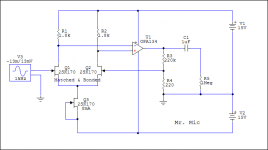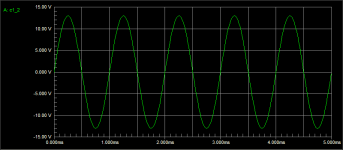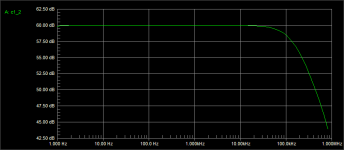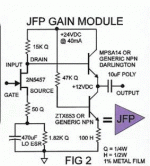Its an experiment I don't recommend it before I test it. Certainly fits best to low MC carts. There can be Jxxx subs for the European BF although noisier, but BF are everywhere. K369 give benefits in the 1/F region and for wide-band 2 are like using 4 K170s. But it can be tried with same IDSS K170s too. Q5 can be used or not to taste. Without Q5, C2 should be 15nF due to more Miller.
Ok, here it is for classic 4XK170BL. You may relax the matching for the quads since they are degenerated enough to share current at ~0.75*IDSS and the total transconductance (~130mS) will be steady for 7.5-9mA samples at shared ID. But make sure that the sum total of the quads IDSS between channels is nearly the same. So the folded cascodes will be sparing the same drive current to R16 and same gain. No loop feedback here to match the gain if not thorough with JFETs picking in both stages. It should present ~15 Ohm input equivalent noise resistance, not bad. And some better input headroom, adequate for normal MC also. Pick a ~5mA BF245A for Q8 and circa 15mA BF245C for Q5.
Latest design share the possibility to use or note of Q5 & C2 15nF?
Hi MerlinLatest design share the possibility to use or note of Q5 & C2 15nF?
Using Q5, you reduce miller on second stage so you might need to add some capacitance to C2 (use 16n instead of 15n).
If you do not cascode second stage, use "normal" C2 values.
This is very long thread now, indeed, and very interesting, but not easy to read it all again.
Besides of the missing symmetrical input your preamp should be useful as a high gain/low impedance microphone preamp, isn't it?
If I let out the RIAA network, do I have to leave a resistor between the stages?
Besides of the missing symmetrical input your preamp should be useful as a high gain/low impedance microphone preamp, isn't it?
If I let out the RIAA network, do I have to leave a resistor between the stages?
Hi Merlin
Using Q5, you reduce miller on second stage so you might need to add some capacitance to C2 (use 16n instead of 15n).
If you do not cascode second stage, use "normal" C2 values.
Thanks Ricardo, so it's the same like with 369s
This is very long thread now, indeed, and very interesting, but not easy to read it all again.
Besides of the missing symmetrical input your preamp should be useful as a high gain/low impedance microphone preamp, isn't it?
If I let out the RIAA network, do I have to leave a resistor between the stages?
It has been used for NAB curve open reel head amplification once but not for microphone. Provide the input level, source impedance and gain needs so we can evaluate if and how it can fit that purpose.
As load resistor is refered to GND, this means current flows inversely in Q3.
Output impedance of first stage is 2k2r right ?
Yes.
It has been used for NAB curve open reel head amplification once but not for microphone. Provide the input level, source impedance and gain needs so we can evaluate if and how it can fit that purpose.
Microphones are very different in out level and impedance, but generally have about 100Ohm source impedance upwards, usually around 200 Ohms. Because level and sound pressure changes the gain needed varies from 50-60db to -say- 20-30db. Real life dynamics exceed the dynamics we know from music productions by far, so the headroom should be very high or the distortion characteristics smooth.
Usually mic preamps have either differential amps as inputs or transformers, also because they are usually balanced.
Have a look at FDW Balanced Phono stage
I got that on the bench at present
Or you can try INA stile made up with LT1038
30dB gain is easy and not much problem with Jhonson noise
http://www.diyaudio.com/forums/analogue-source/165603-balanced-input-all-dc-coupled-riaa-preamp.html
I got that on the bench at present
Or you can try INA stile made up with LT1038
30dB gain is easy and not much problem with Jhonson noise
http://www.diyaudio.com/forums/analogue-source/165603-balanced-input-all-dc-coupled-riaa-preamp.html
Microphones are very different in out level and impedance, but generally have about 100Ohm source impedance upwards, usually around 200 Ohms. Because level and sound pressure changes the gain needed varies from 50-60db to -say- 20-30db. Real life dynamics exceed the dynamics we know from music productions by far, so the headroom should be very high or the distortion characteristics smooth.
Usually mic preamps have either differential amps as inputs or transformers, also because they are usually balanced.
The simplest I could think of is a Jfet dif amp input handing over to a Jfet input opamp. It can swing 26Vpp this one. Its 60dB gain can be padded down by switching resistors parallel to R3 or by shunting a pot. G=(R3/R4)+1. Balanced Mic transformer coupling offers the best CMRR and sound anyway so its preferable if in hand to keep the electronics SE and minimal. Jfet cascoding, other worthwhile Jfet types, easily applicable. Housekeeping like opamp decoupling, sizing C1 to likely impedance it will meet, PSU etc. goes without saying.
Attachments
Thank you , Salas.
But topologies like this have been done many times, sometimes with cascoding, and other variations.
What I meant - and maybe it was a bit naive - was, if it may be possible to use your circuit as a micpre. I like the simplicity and the possible "sound".
Of course with a unbalanced input cables must be quite short and only unbalanced or non-active microphones can be used. But there are ribbon microphones, which usually have a step-up transformer built in, and some other very quiet dynamic microphones, which could possibly benefit. And for balancing I can use a transformer anyway.
I use another simple mic-pre in an experimental state right now, and was wondering if your circuit may not be better.
It uses two of these stages in series and a transformer in front.
But topologies like this have been done many times, sometimes with cascoding, and other variations.
What I meant - and maybe it was a bit naive - was, if it may be possible to use your circuit as a micpre. I like the simplicity and the possible "sound".
Of course with a unbalanced input cables must be quite short and only unbalanced or non-active microphones can be used. But there are ribbon microphones, which usually have a step-up transformer built in, and some other very quiet dynamic microphones, which could possibly benefit. And for balancing I can use a transformer anyway.
I use another simple mic-pre in an experimental state right now, and was wondering if your circuit may not be better.
It uses two of these stages in series and a transformer in front.
Attachments
Are you/we OK with that?
They nil out since they are common DC to inverting and non inverting inputs. The offset and the signal is what gets amplified. C1 is for the inevitable offset especially without single die dual Jfets like 2SK389 which are commonly unavailable these days.
Thank you , Salas.
But topologies like this have been done many times, sometimes with cascoding, and other variations.
What I meant - and maybe it was a bit naive - was, if it may be possible to use your circuit as a micpre. I like the simplicity and the possible "sound".
Of course with a unbalanced input cables must be quite short and only unbalanced or non-active microphones can be used. But there are ribbon microphones, which usually have a step-up transformer built in, and some other very quiet dynamic microphones, which could possibly benefit. And for balancing I can use a transformer anyway.
I use another simple mic-pre in an experimental state right now, and was wondering if your circuit may not be better.
It uses two of these stages in series and a transformer in front.
I see what you are after, but if you will choose this non feedback gain controlled approach you should settle for about 40dB middle of the way gain because the bias points would need some determined swing headroom, and it will not be that easy to change parameters on the fly. Maybe a 1:10 mic trafo and a 30dB output voltage divider switchable pad can make it more versatile. Will check out and give you a flat gain one based on the simplistic. Any simplistic is +20dB on nominal without the passive RIAA loss so it takes some recalculation.
After posting elsewere about the qualities of another riaa preamp I could not resist to leave my other opinion here.
Some say the Simplistic has special staging qualities. I did find it to be true and never heard anything aproaching the Simplistic in this area (not even the best jfet EB implementations that I had the oportunity to evaluate). Off course this can only be obtained with a very carefull layout implementation and carefull choice of components. IMO the type of shunt used is determinant.
Apart from staging, the Simplistic can have the sweetest mid/trebble causing a magical transe state on the listener....
Off course it might be difficult to get all this at first start (it took me a while to get here) but diy difficulties should never stop those who are really determined.
This post serves to remove all doubts about my subjective evaluation of this superlative design by Salas.
Some say the Simplistic has special staging qualities. I did find it to be true and never heard anything aproaching the Simplistic in this area (not even the best jfet EB implementations that I had the oportunity to evaluate). Off course this can only be obtained with a very carefull layout implementation and carefull choice of components. IMO the type of shunt used is determinant.
Apart from staging, the Simplistic can have the sweetest mid/trebble causing a magical transe state on the listener....
Off course it might be difficult to get all this at first start (it took me a while to get here) but diy difficulties should never stop those who are really determined.
This post serves to remove all doubts about my subjective evaluation of this superlative design by Salas.
- Home
- Source & Line
- Analogue Source
- Simplistic NJFET RIAA



